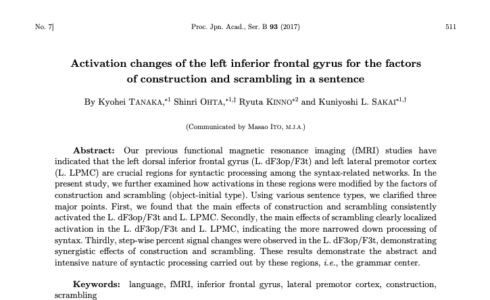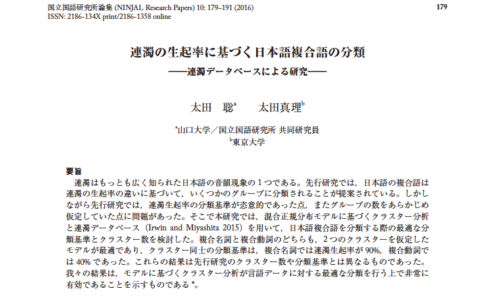Nakajima & Ohta (2023) Issues in Japanese Psycholinguistics from Comparative Perspectives
Nakajima, J., Ohta, S., “(Dis)similarities between semantically transparent and lexicalized nominal suffixation in Japanese: An ERP study using a masked priming paradigm,” In Koizumi, M. (Ed.), Issues in Japanese Psycholinguistics from Comparative Perspectives: Interaction between Linguistic and Nonlinguistic Factors (Vol. 2) (The Mouton-NINJAL Library of Linguistics Series) (pp. 133–162), Berlin/Boston, De Gruyter Mouton, 2023. doi: 10.1515/9783110778939-008
Using electroencephalography (EEG), we investigate the neural mechanism for processing complex words by examining the ERP components, N400 and N170, crucial for lexical processing in the brain. We employ the masked priming paradigm to test the neural mechanism of morpho-orthographic and semantic aspects by behavioral and electrophysiological evidence. The primary aim is to demonstrate neurolinguistic evidence of processing two types of Japanese de-adjectival nouns (-sa nouns and -mi nouns). We test the hypothesis that the two types of Japanese de-adjectival nouns are processed by common neural mechanisms, especially in an earlier stage (i.e., morphological decomposition). Given their lexicalized meanings, we further hypothesize that -mi nouns will show a larger N400 peak than -sa nouns in the later stage, which reflects lexical access and recombination of morphemes.
In the present study, we obtained three striking results. First, we demonstrated the significant priming effects on the N400, as well as the significant laterality effects on the N170, for -sa and -mi nouns. These results suggest that morphologically complex words were processed by a common neural mechanism (i.e., similarity). It accords with studies of complex word processing in English. Moreover, we found a larger N400 and lower behavioral performance (lower accuracy and longer RTs) for -mi nouns given their lexicalized meaning (i.e., dissimilarity). Second, by using the linear mixed-effects models, we showed that the transition probability (TP) from adjectival stem to suffix and the amplitude of the N400 showed significant negative modulations in the bilateral parieto-occipital regions. These results indicate that the TP attenuates the amplitude of the N400. Third, both types of derived nouns showed significant morphological priming effects in the behavioral data (shorter RTs and lower error rates). Although further evidence is required to establish a more detailed mechanism for word recognition, the neural and behavioral results clearly showed a common processing mechanism of the two types of derived nouns in the earlier stage (i.e., morphological decomposition). In the later stage, which reflects lexical access and recombination of morphemes, different neural mechanisms processed the two types of de-adjectival nouns. These results show the similarities and dissimilarities of the neural mechanisms, which were also proposed in the past-tense debate in English, for processing two types of de-adjectival nouns in Japanese. By demonstrating that the Japanese word-processing mechanism accords with that of typologically different languages, this study contributes to elucidating the cross-linguistic universality of the neural basis of morphological processing.
This research was supported by JSPS KAKENHI [Grant Number JP22J11843], JST SPRING [Grant Number JPMJSP2136 (to JN)], and JSPS KAKENHI [Grant Numbers JP19H01256, JP21K18560, JP17H06379, and JP19H05589], a Grant for Basic Science Research Projects from the Sumitomo Foundation, a Research Grant from the Yoshida Foundation for the Promotion of Learning and Education, and the QR Program and SENTAN-Q Program from Kyushu University (to SO).






